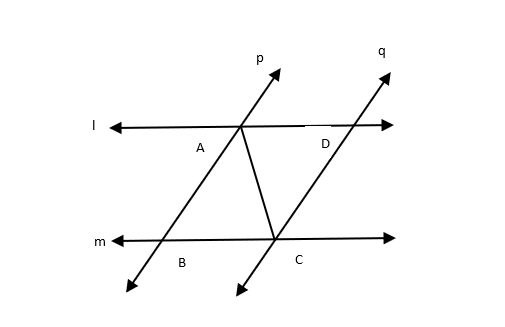
Answer
501.3k+ views
Hint- Use the properties of similarity of triangles.
Given: $l\parallel m$ and $p\parallel q$
Taking $l\parallel m$ and $AC$ is the traversal,
$\angle ACB = \angle CAD{\text{ }} \ldots \ldots \left( 1 \right){\text{ }}\left( {\because {\text{Alternate angles}}} \right)$
Considering $p\parallel q$ and $AC$ is the traversal,
$\angle BAC = \angle DCA{\text{ }} \ldots \ldots \left( 2 \right){\text{ }}\left( {\because {\text{Alternate angles}}} \right)$
In $\Delta ABC$ and $\Delta CDA$:
$
\angle ACB = \angle CAD{\text{ }}\left( {{\text{from }}\left( 1 \right)} \right) \\
AC = CA {\text{ }}\left( {{\text{common}}} \right) \\
\angle BAC = \angle DCA{\text{ }}\left( {{\text{from }}\left( 2 \right)} \right) \\
$
Therefore, using ASA congruence rule, we can say:
${\text{ }}\Delta ABC \cong \Delta CDA$
Hence Proved.
Note- When two triangles are congruent, they will have exactly the same three sides and exactly the same three angles. Although these equal sides and angles may not be at the exact same position. Also, there are criteria like SAS, ASA, SSS to prove triangles are congruent
Given: $l\parallel m$ and $p\parallel q$
Taking $l\parallel m$ and $AC$ is the traversal,
$\angle ACB = \angle CAD{\text{ }} \ldots \ldots \left( 1 \right){\text{ }}\left( {\because {\text{Alternate angles}}} \right)$
Considering $p\parallel q$ and $AC$ is the traversal,
$\angle BAC = \angle DCA{\text{ }} \ldots \ldots \left( 2 \right){\text{ }}\left( {\because {\text{Alternate angles}}} \right)$
In $\Delta ABC$ and $\Delta CDA$:
$
\angle ACB = \angle CAD{\text{ }}\left( {{\text{from }}\left( 1 \right)} \right) \\
AC = CA {\text{ }}\left( {{\text{common}}} \right) \\
\angle BAC = \angle DCA{\text{ }}\left( {{\text{from }}\left( 2 \right)} \right) \\
$
Therefore, using ASA congruence rule, we can say:
${\text{ }}\Delta ABC \cong \Delta CDA$
Hence Proved.
Note- When two triangles are congruent, they will have exactly the same three sides and exactly the same three angles. Although these equal sides and angles may not be at the exact same position. Also, there are criteria like SAS, ASA, SSS to prove triangles are congruent
Recently Updated Pages
Fill in the blanks with suitable prepositions Break class 10 english CBSE

Fill in the blanks with suitable articles Tribune is class 10 english CBSE

Rearrange the following words and phrases to form a class 10 english CBSE

Select the opposite of the given word Permit aGive class 10 english CBSE

Fill in the blank with the most appropriate option class 10 english CBSE

Some places have oneline notices Which option is a class 10 english CBSE

Trending doubts
Fill the blanks with the suitable prepositions 1 The class 9 english CBSE

How do you graph the function fx 4x class 9 maths CBSE

When was Karauli Praja Mandal established 11934 21936 class 10 social science CBSE

Which are the Top 10 Largest Countries of the World?

What is the definite integral of zero a constant b class 12 maths CBSE

Why is steel more elastic than rubber class 11 physics CBSE

Distinguish between the following Ferrous and nonferrous class 9 social science CBSE

The Equation xxx + 2 is Satisfied when x is Equal to Class 10 Maths

Differentiate between homogeneous and heterogeneous class 12 chemistry CBSE





